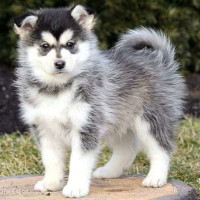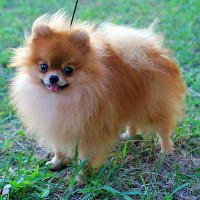 |
Pomsky |
|
He is not recognized by the F.C.I. |
Origin |
Germany <> Siberia -> U.S.A. | |
Translation |
Francis Vandersteen |
A brief presentation of the Pomsky |
| Pomsky, the unlikely but adorable marriage of Siberian Husky and Pomeranian, is a novelty in the landscape of specific crossbreed dogs. These two breeds are very different in size, but share many physical traits, and their puppies are invariably fluffy balls of fluff. Pomskies are energetic, playful little dogs that are generally highly intelligent and easy to train. Although they can be kept as indoor dogs, they need plenty of exercise and are renowned for their parent-like hunting power, which means they'll leave a furry trail around the house. Most are very kind and gentle with children, although the Pomeranian is not always so inclined and each hybrid dog is judged individually, as the traits of one or other parent may be more pronounced. Pomskies also often show the Pomeranian's protective instincts, and can make good watchdogs, although they are generally too small to pose a real threat to a determined intruder. Both parent breeds are very vocal, and the Pomsky can inherit the howl of the Husky and the voice of the Pomeranian, producing a cacophony of sound when alarmed or annoyed. This vocalization can be a problem in dogs left alone during the day, and should be taken into account by owners who have to leave home for work. The Pomsky's incredibly dense coat offers sufficient protection against the cold, but becomes a handicap in hot weather. This hybrid needs to be protected from the elements during the hottest summer months. They are generally very healthy dogs with a life expectancy of 13 to 15 years, but this range is based on assumptions rather than data, as the Pomsky has only recently been bred. |
History of the Pomsky |
| It seems only in the last five years that the Pomsky has become widely available, but there has been a rapid increase in demand, mainly based on its irresistible appearance. All hybrid matings involve a large element of chance, as the offspring will inherit the characteristics of the parent at random, so a litter of Pomsky puppies may vary in appearance and temperament. However, Siberian Huskies and Pomeranians share the same Arctic heritage, and their similar coats and body shapes mean that the variability in appearance of their puppies is often more a question of size than substance. In general, the Pomeranian is the sire, as the reverse would be likely to create major birthing difficulties. The personalities of the two parent breeds offer an interesting contrast, and it's here that the Pomsky's margin for variation is perhaps greatest. So, where does the Pomsky spectrum lie between Husky and Pomeranian? Unfortunately, we can't say for sure, but we hope that most of them will mix these characteristics more or less uniformly. |
A little of the German Toy Spitz / Pomeranian |
||
| Pomeranians are the smallest Spitz-type dogs. They feature the classic coat, erect ears, pointed muzzle and curved tail that give them that much-loved foxy look. Although they are much smaller, they are in fact closely related to breeds such as Samoyede and Keeshond. Pomeranians were first bred in a historic place called Pomerania, on the shores of the Baltic Sea, around the 18th century. A dog with a truly noble background, it was Queen Victoria of England who shone with them during her reign. Many experts believe that it was only thanks to Queen Victoria's efforts that the breed was reduced to around 50% of its original size, due to her desire for ever-smaller Pomeranians. They are currently classified in the Kennel Club Services group and are regularly used as therapy pets due to their intelligence and docile nature. | ||
 |
||
| Standard of the German Toy Spitz / Pomeranian | ||
A little of the Siberian Husky |
||
| Siberian Huskies are medium-sized, intelligent, gentle and friendly dogs. They were originally bred by the Chukchi Indians in the Soviet Arctic and provided them with an essential means of survival, serving both as transport sled dogs and hunting aids. Today, they continue to be used as sled dogs, but are also excellent companions for active households, as they have great stamina and need plenty of exercise. | ||
 |
||
| Standard of the Siberian Husky |
Appearance of the Pomsky |
| Most Pomskies are quite small, but their height varies from 25 to 38 cm at the withers, and they weigh between 9 and 14 kg. They are prone to obesity, which can be masked by their thick coats. So check regularly that the ribs and spinal points are just palpable under the hair. They generally resemble miniature Huskies and have a dense, insulating coat that is a combination of black, gray, red and white. They have a particularly thick ruff around the neck that forms a mane. The head resembles that of a wolf, with large, erect ears and eyes that can be a range of colors, and may even be different from one another. The muzzle can be quite thin compared to the skull in some smaller individuals, and the body is athletic in its proportions. The Pomsky has reasonably long, well-muscled limbs and a curved tail that is held over the back, even at rest. |
Temperament of the Pomsky |
| As explained above, genetic lottery can result in Pomskies having very different temperaments, potentially even within litters. However, it's fair to generalize that most are extremely playful and good-humored. Unlike Pomeranians, they tend to be gentle and tolerant of children, although smaller Pomskies can be more delicate and easily injured, so they may be better suited to older children. They are highly intelligent hybrids, and bond closely with their owners, sometimes even more so with a family member. They have the instinct to protect their family and territory, and can make very good watchdogs, but their ability to bark loudly and for a long time while sounding the alarm can lead to inopportune barking, especially when bored. Like any dog, the Pomsky needs companionship and stimulation, and it's important to provide opportunities for socialization and play, as well as a range of entertaining toys, so that this energetic dog doesn't become destructive or hyperactive. |
Needs and activities of the Pomsky |
| Pomskies are active dogs who need a good amount of physical activity to expend their energy and stay healthy. A daily 30-minute walk is highly recommended. In addition, he may need time to play or run in a park or yard, to completely drain off his energy. Generally, these dogs also like to swim, but you should never leave them alone. This intelligent dog also needs mental stimulation so that toys or activities that challenge his intellect are well received. You can get him a toy or a puzzle and play a game of treasure hunt. They're good apartment dogs who like to stretch their legs on a pleasant walk outdoors and are adapted to the cold, provided they're dressed to withstand the extreme elements. |
Maintenance of the Pomsky |
| The Pomsky is a great shedder, especially if it has more Pomeranian DNA. You should brush him every day, using a brush to remove dead hairs and a smooth brush to remove mats and tangles. Remember to always remove tangles before bathing. Bathe him from time to time, when he's dirty, to avoid drying out his skin. You should also take your dog to the groomer every three months to have his hair trimmed, as this will make things easier. It's a good idea to clean his ears every week to avoid infections, excess moisture or wax build-up. It's also very important to brush his teeth every day, as these dogs are prone to dental problems. |






 English (United Kingdom)
English (United Kingdom)